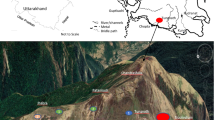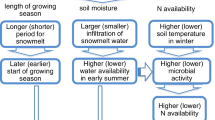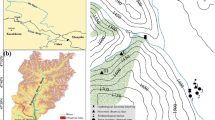Abstract
Snow resisting capacity of vegetation is important for secondary distribution of water resources in seasonal snow areas of grassland because it affects the regeneration, growth and nutrient circulation of vegetation in grassland. This study investigated vegetation characteristics (canopy height, canopy length and crown width) of Caragana microphylla Lam. (shrub) and Achnatherum splendens (Trin.) Nevski. (herb), and snow morphologies (snow depth, snow width and snow braid length) in a typical steppe region of Inner Mongolia, China in 2017. And the influence of vegetation characteristic on snow resisting capacity (the indices of bottom area of snow and snow volume reflect snow resisting capacity) was analyzed. The results showed that snow morphology depends on vegetation characteristics of shrub and herb. The canopy height was found to have the greatest influence on snow depth and the crown width had the greatest influence on snow width. The canopy length was found to have little influence on morphological parameters of snow. When the windward areas of C. microphylla and A. splendens were within the ranges of 0.0–0.5 m2 and 0.0–8.0 m2, respectively, the variation of snow cover was large; however, beyond these areas, the variation of snow cover became gradually stable. The potential area of snow retardation for a single plant was 1.5–2.5 m2 and the amount of snow resistance was 0.15–0.20 m3. The bottom area of snow and snow volume (i.e., snow resisting capacity) of clumped C. microphylla and A. splendens was found to be 4 and 25 times that of individual plant, respectively. The results could provide a theoretical basis both for the estimation of snow cover and the establishment of a plant-based technical system for the control of windblown snow in the typical steppe region of Inner Mongolia.
Similar content being viewed by others
References
Ash J E, Wasson R J. 1983. Vegetation and sand mobility in the Australian desert dunefield. Zeitschift für Geomorphologie Supplementband, 45: 7–25.
Cacitua G, Bay C, Pedersen M R, et al. 2013. Quantifying snow and vegetation interactions in the High Arctic based on ground penetrating radar (GPR). Arctic, Antarctic, and Alpine Research, 45(2): 201–210.
Conner L, Gill R, Harvey J. 2017. Earlier snowmelt accompanied by warmer soil temperatures in mid-latitude aspen forest and subalpine meadow: Implications for soil carbon. Plant and Soil, 417(1–2): 275–285.
Cornelissen J H C, Makoto K. 2014. Winter climate change, plant traits and nutrient and carbon cycling in cold biomes. Ecological Research, 29(4): 517–527.
Dolman A J, Hall A J, Kavvas M L, et al. 2001. Soil-Vegetation-Atmosphere Transfer Schemes and Large-Scale Hydrological Models. Wallingford: IAHS Press, 317–325.
Essery R, Pomeroy J. 2004. Vegetation and topographic control of wind-blown snow distributions in distributed and aggregated simulations for an Arctic tundra basin. Journal of Hydrometeorology, 5(5): 735–744.
Frank A, Kocurek K. 1996. Toward a model for airflow on the lee side of aeolian dunes. Sedimentology, 43(3): 451–458.
Gavazov K, Ingrisch J, Hasibeder R, et al. 2017. Winter ecology of a subalpine grassland: Effects of snow removal on soil respiration, microbial structure and function. Science of the Total Environment, 590–591: 316–324.
Gray D M. 1979. Snow accumulation and redistribution. In: Colbeck S C, Ray M. Proceedings, Modeling of Snow Cover Runoff. Hanover: U.S. Army Cold Regions Research and Engineering Laboratory, 3–33.
Hallinger M, Manthey M, Wilmking M. 2010. Establishing a missing link: warm summers and winter snow cover promote shrub expansion into alpine tundra in Scandinavia. New Phytologist, 186(4): 890–899.
Hao L, Gao J M, Yang C Y. 2006. Snow disaster system of grassland animal husbandry and control countermeasures. Pratacultural Science, 6: 48–54. (in Chinese)
Johansson M, Callaghan T V, Bosio J, et al. 2013. Rapid responses of permafrost and vegetation to experimentally increased snow cover in sub-arctic Sweden. Environmental Research Letters, 8(3): 035025.
Jones H G, Pomeroy J W, Walker D A, et al. 2001. Snow Ecology: An Interdisciplinary Examination of Snow-covered Ecosystems. Cambridge: Cambridge University Press, 34–48.
Lawrence D M, Oleson K W, Flanner M G, et al. 2011. Parameterization improvements and functional and structural advances in version 4 of the community land model. Journal of Advances in Modeling Earth Systems, 3(1): 1–27.
Leonard K C, Maksym T. 2011. The importance of wind-blown snow redistribution to snow accumulation on Bellingshausen Sea Ice. Annals of Glaciology, 52(57): 271–278.
Liston G E, Hiemstra C A. 2011. Representing grass and shrub snow atmosphere interactions in climate system models. Journal of Climate, 24(8): 2061–2079.
Marion G M, Henry G H R, Freckman D, et al. 1997. Open-top designs for manipulating field temperature in high-latitude ecosystems. Global Change Boil, 3(S1): 30–32.
Marsh P, Bartlett P, MacKay M, et al. 2010. Snowmelt energetics at a shrub tundra site in the western Canadian Arctic. Hydrological Processes, 24(25): 3603–3620.
Ménard C B, Essery R, Pomeroy J, et al. 2014. A shrub bending model to calculate the albedo of shrub-tundra. Hydrological Processes, 28(2): 341–351.
Musick H B, Gillette D A. 1990. Field evaluation of relationships between a vegetation structural parameter and sheltering against wind erosion. Land Degradation and Development, 2(2): 87–94.
Myers-Smith I H. 2011. Shrub encroachment in Arctic and alpine tundra: mechanisms of expansion and ecosystem impacts. PhD Dissertation. Edmonton: University of Alberta, 7–19.
Naito A T, Cairns D M. 2011. Patterns and processes of global shrub expansion. Progress in Physical Geography, 35(4): 423–442.
Pomeroy J W, Marsh P, Gray D M. 1997. Application of a distributed blowing snow model to the Arctic. Hydrological Processes, 11(11): 1454–1464.
Pomeroy J W, Bewley D S, Essery R, et al. 2006. Shrub tundra snowmelt. Hydrological Processes, 20(4): 923–941.
Schmidt N M, Baittinger C, Kollmann J, et al. 2010. Consistent dendrochronological response of the dioecious Salix arctica to variation in local snow precipitation across gender and vegetation types. Arctic Antarctic and Alpine Research, 42(4): 471–475.
Sturm M, McFadden J P, Liston G E, et al. 2001. Snow-shrub interactions in Arctic tundra: A hypothesis with climatic implications. Journal of Climate, 14(3): 336–344.
Sturm M, Douglas T, Racine C, et al. 2005. Changing snow and shrub conditions affect albedo with global implications. Journal of Geophysical Research: Biogeosciences, 110(G1): 1–13.
Tinkham W T, Smith A, Marshall H P, et al. 2014. Quantifying spatial distribution of snow depth errors from LiDAR using Random Forest. Remote Sensing of Environment, 141: 105–115.
Tommaso C, Sprugnoli R, Manuela S, et al. 2014. Evaluation of events and temporal information at Evalita. In: Proceedings of the First Italian Conference on Computational Linguistics CLiC-it 2014 & the Fourth International Workshop. Evalita: Pisa University Press.
Walker I J, Nickling W C. 2002. Dynamics of secondary airflow and sediment transport over and in the lee of transverse dunes. Progress in Physical Geography, 26(1): 47–75.
Walker K D, Ingersoll R C, Webber P J. 1995. Effects of interannual climate variation on phenology and growth of two alpine forbs. Ecology, 76(4): 1067–1083.
Wipf S, Rixen C. 2010. A review of snow manipulation experiments in Arctic and alpine tundra ecosystems. Polar Research, 29(1): 95–109.
Yan M, Zuo H J, Dong Z, et al. 2018. Capacity of Caragana microphylla shrub on counteracting snow movement and its influence on snow morphology in the Xilinhot Steppe, China. Chinese Journal of Applied Ecology, 29(2): 483–491. (in Chinese)
Acknowledgements
This work was supported by the National Natural Science Foundation of China (41361012), and the Postgraduate Research and Innovation Funding Project of Inner Mongolia Autonomous Region (B2018111951).
Author information
Authors and Affiliations
Corresponding author
Rights and permissions
About this article
Cite this article
Yan, M., Zuo, H., Wang, H. et al. Snow resisting capacity of Caragana microphylla and Achnatherum splendens in a typical steppe region of Inner Mongolia, China. J. Arid Land 12, 294–302 (2020). https://doi.org/10.1007/s40333-019-0021-x
Received:
Revised:
Accepted:
Published:
Issue Date:
DOI: https://doi.org/10.1007/s40333-019-0021-x




